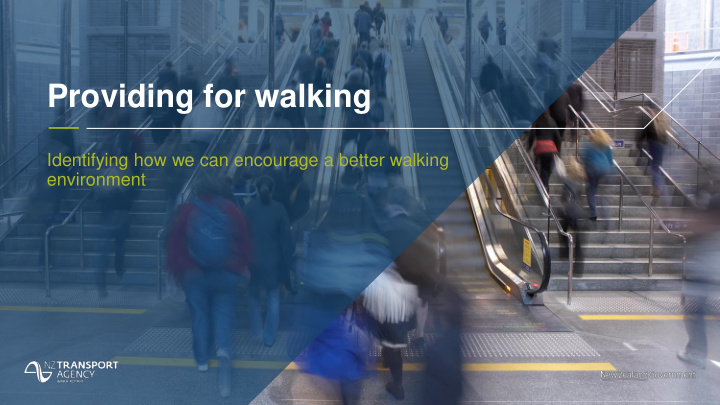



Providing for walking Identifying how we can encourage a better walking environment
Walking in the transport system Every journey has an element of walking It’s integral to the system, influenced by a range of factors and an influencer itself.
Integration between modes Streetscape design Land use zoning Walking environments Accessible design Policy Safety
How we support the system • Pedestrian planning and design guide (2009) • RTS14 Guidelines for facilities for blind and vision impaired pedestrians (2015) • Subsidise walking projects, and maintenance and renewals of pedestrian facilities through the NLTP (informed by the GPS) • Less directly through Austroads Guidance, TCD Manual, State Highway Control, Bridging the Gap Recent activities • Review of design guidance, and funding processes (which has identified a programme of improvements) • Research into barriers to walking
How are we doing? Strategy and policy Strategy and policy Funding process support Funding process support Audit and Audit and review review Guidance Guidance Implementation Implementation Training Training Measuring Measuring success success Awareness and industry engagement
Opportunities – strategy and policy At a national level we are doing well through the 2018 GPS and IAF • These changes need to trickle down into local level strategy and policy • More time is required to see strategy and policy changes influence investment programmes • Require guidance to define a strategic pedestrian network
Opportunities – funding process support • Undertake a detailed review to identify how barriers to investing in pedestrian improvements can be removed, and to ensure that the EEM is fully aligned to the Government’s direction to implement the speed management framework. • A single point of funding guidance, and demonstration of how the various processes fit together • More support for local authorities through the funding process • Establish special funding projects (similar to model communities) • Provide funding case studies • Establish standard BCRs for intervention types (as is happening in road safety) • Provide guidance to define a strategic pedestrian network • Develop a pedestrian Level of Service framework to inform investment
Opportunities – guidance • Combine PPDG and RTS14 into one on-line guidance resource • Develop the Pedestrian Network Guidance (PNG) structure to guide content development • Develop programme of guidance improvements/development based on the gaps identified in this review • Update the Speed Management Guide to strengthen consideration of pedestrian safety and comfort • Audit a sample of local authority guidance (e.g. Codes of Practice) for consistency with PPDG and RTS14 • Review the need to retain RTS series and consider integrating these into appropriate existing guidance • Address other NZ Transport Agency guidance as identified in this review when the opportunity arises • Pursue opportunities to embed pedestrian design principles in all NZ Transport Agency documents
Opportunities – implementation This aspect has not been reviewed, however, an opportunity has been identified to: • Develop a TGSI design and installation guidance note for certain sectors, such as designers and contractors who install TGSIs
Opportunities – audit and review • Establish pedestrian audit procedures through the design stages, and post construction • Establish a lessons learnt review process to inform future design and construction, and to inform guidance development
Opportunities – measuring success • Develop a method to better understand the quantum of walking and quality of the walking environment • Establish baseline data • Establish key performance indicators to measure against • Develop a home for the data
Opportunities – training • Consider when awareness of the guidance should be raised (now or after updated guidance?) • Increase awareness through industry forums, publications and other means • Consider industry training based on new format and content (timing)
Opportunities – awareness and industry engagement Engage further with: • The Property Council re: ‘walkability’ in land development • NZ Planning Institute re: supporting walkability through land use planning and District Plans • The disability sector re: planning and design aspects not already covered in the guidance
We have a great opportunity to encourage more walking, and a better walking environment.
Recommend
More recommend